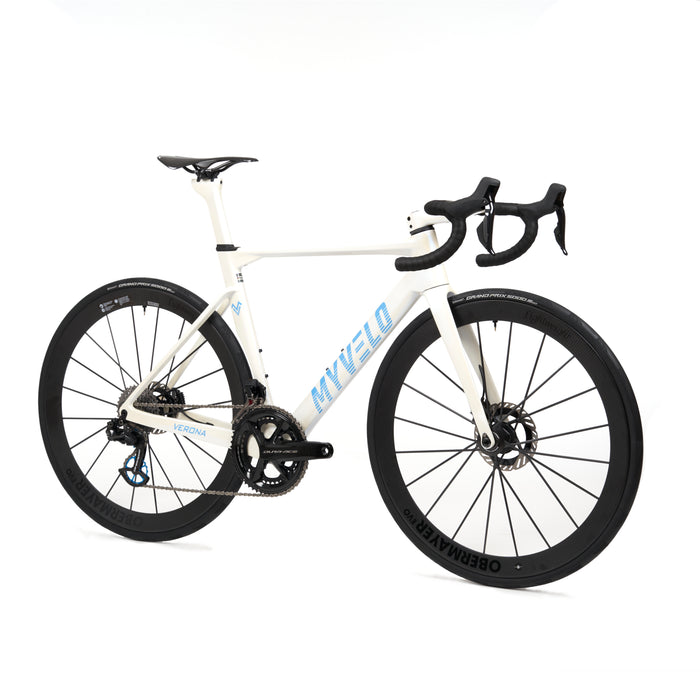
Verona Road Bike - Ltd. 33
incl. FREE shipping & free returns

Von Fabian Huber |
5 minutes read time

This inconspicuous component is crucial for rolling resistance, handling and comfort in the saddle. The difference between a narrow and a wide tire can be less obvious than you might think.
This post will delve deeper into the subject of tire width, revealing how it can affect performance and ride comfort on different road surfaces. There will be a detailed analysis of the pros and cons of different tire widths to help you make an informed decision and improve your road cycling experience.
In the context of road cycling, the tire width plays a decisive role in the driving characteristics. It influences, among other things, the rolling resistance, the grip and the driving feel. Various factors play a role in choosing the tire width:
As a rule of thumb, the harder and smoother the road surface, the narrower the tire can be. Wide tires are an advantage on rough roads. Practical examples show that many professional racing cyclists choose tire widths of 28mm or more on cobblestone races such as Paris-Roubaix, while 23mm or 25mm are often used on smooth asphalt roads.
However, there are limits: tires that are too wide may not fit every frame and can lead to increased air resistance. So it is important to find the right balance and adjust the tire width to your personal needs and the given track conditions. Thorough research and advice can be very helpful here.
Choosing the right tire width for your road bike can have a big impact on performance and handling. There are a few important factors to consider:
When choosing the tire width for your road bike, it is important to find a compromise between these different factors. A wider tire choice can increase comfort and efficiency, while a narrower tire choice may result in better acceleration and higher speeds. Ultimately, the best choice depends on your personal preference and the specific conditions of your rides.
When it comes to choosing the right tire width for your vehicle, there are a few factors to consider. Tire width has a significant impact on the handling and performance of your car. A wider tire surface generally provides more grip on the road, resulting in better steering and a more stable ride. In addition, wider tires can also improve braking performance and thus offer greater safety.
However, wider tires also have their disadvantages. They increase rolling resistance, which leads to higher fuel consumption. They can also increase the risk of aquaplaning in wet or snowy conditions because the water cannot be drained away as quickly.
Narrower tires, on the other hand, have lower rolling resistance, which leads to better fuel efficiency. They are often quieter and offer better handling in snow and ice because they concentrate pressure on a smaller area, thus allowing better traction:
Wide tires:
Narrow tires:
Choosing the right tire width depends on various factors, such as driving conditions, your driving style and the specific requirements of your vehicle. It is important to carefully weigh up all the pros and cons in order to make the best decision for you and your vehicle.
Tire width plays a crucial role in road cycling. It depends primarily on the riding style and the road conditions. Generally speaking, the wider the tire, the more comfortable it offers, as it absorbs bumps better.
A narrow tire, around 23 mm wide, is ideal for dry and flat surfaces. It has less rolling resistance and therefore offers better performance. On the other hand, for wet or uneven surfaces, a wider tire, for example 25 or 28 mm, is recommended. It offers more grip and safety.
Here are the most important points in brief:
So next time you're faced with the choice of which tires to choose for your road bike, consider the conditions of your preferred tracks and remember that comfort and performance go hand in hand. So it's worth investing a little time in choosing the right tire width to optimize your performance and improve your riding experience.
There have been some notable trends and developments in road cycling in recent years, particularly in tires. The trend is increasingly moving toward wider tires as they offer better traction and control on different surfaces.
Choosing the right tires can make the difference between winning and losing, so it's worth knowing the latest developments. But it's not just professionals who benefit from these trends. For amateur riders too, wider, tubeless tires and high-quality materials can increase riding comfort and safety. Try it out and feel the difference!
Choosing the right tire width for your road bike can be a challenge considering the many factors that come into play. It's not just about speed and comfort, but also safety and durability. Here are some key points to consider:
Practical examples confirm these points. A study by the University of Colorado has shown that wider tires consume less energy than narrower ones for the same performance.
So your decision should be based on your individual needs. Remember: the right tire is the one that offers you a safe and comfortable driving experience. And don't forget to check your tires regularly for wear and adjust the air pressure!

Als Rennradfahrer möchte man möglichst ständig besser werden: schneller, ausdauernder und effizienter. Doch was, wenn der Schlüssel zu diesen Zielen nicht nur auf zwei Rädern liegt? Rudern, oft unterschätzt, bietet eine ideale Ergänzung zum Radtraining. Es trainiert nicht nur den ganzen Körper, sondern verbessert auch die Ausdauer, Kraft und Stabilität – entscheidende Faktoren für jeden Radsportler.

Nach einer intensiven Rennrad-Einheit ist die richtige Regeneration entscheidend, um Leistung zu verbessern, Verletzungen zu vermeiden und langfristig Fortschritte zu erzielen. Doch wie sieht eine effektive Erholung aus? Hier bekommst Du die besten Tipps zur optimalen Regeneration nach dem Rennradtraining.

Erfahre, wie Radsport-Ligen aufgebaut sind und weitere Infos zur Organisation im Profi-Radsport!